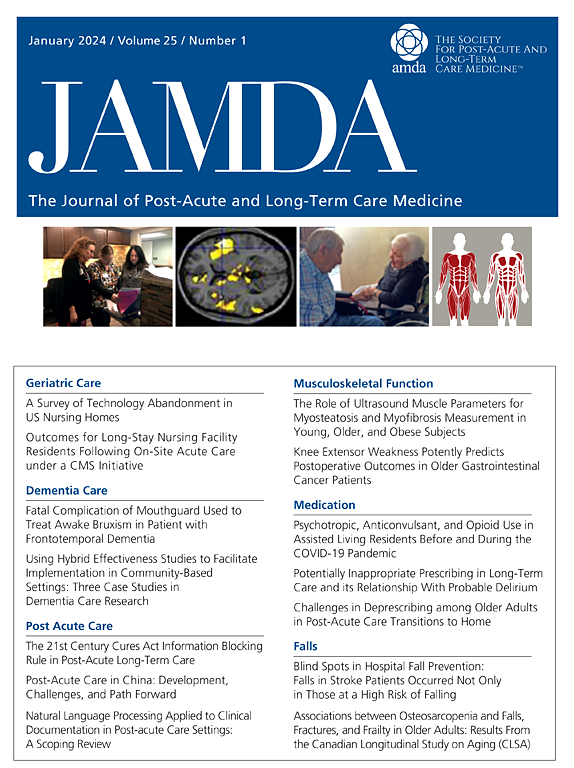Short-Term Immunogenicity of Licensed Subunit RSV Vaccines in Residents of Long-Term Care Facilities (LTCF) Compared to Community-Dwelling Older Adults
IF 4.2
2区 医学
Q2 GERIATRICS & GERONTOLOGY
Journal of the American Medical Directors Association
Pub Date : 2024-09-21
DOI:10.1016/j.jamda.2024.105281
引用次数: 0
Abstract
Objectives
Phase 3 licensing trials for the recently approved respiratory syncytial virus (RSV) vaccines did not include many residents of long-term care facilities (LTCF). Our primary objective was to assess humoral immune responses in LTCF residents, aged 60 and older, to the RSV vaccines, and demonstrate noninferiority to antibody responses in community-dwelling (CD) adults who were representative of the phase 3 trial participants in whom the vaccines were highly efficacious.
Design
Prospective non-randomized intervention trial of RSV vaccines in LTCF residents.
Setting and Participants
Research clinic and 2 LTCFs. Adults aged ≥60 years old, free of immunosuppression and planning to receive an RSV vaccine were eligible.
Methods
LTCF and CD participants received either the GSK or Pfizer RSV vaccine in equal numbers. Blood was collected before and 30 days after vaccination. Total immunoglobulin (Ig)G to the prefusion F protein of RSV group A (FA) and B (FB), and neutralizing activity were measured, and geometric mean titer (GMT) and geometric mean fold rise (GMFR) calculated. Intercurrent respiratory illnesses were tracked.
Results
A total of 76 LTCF residents and 76 CD adults were enrolled. Day 30 blood was unavailable from 3 residents and 3 had RSV infection and vaccination was deferred, leaving data for 76 CD and 70 LTCF adults for analysis. Serum IgG GMFR prefusion FA (9.9 vs 12.5, P = .14), prefusion FB (8.7 vs 11.0, P = .17) were not statistically different in CD and LTCF cohorts, respectively, and also equivalent for GMFR in viral neutralization titers (12.8 vs. 15.5, P = .32). As measured by GMT or GMFR, RSV vaccine responses of LTCF residents met noninferiority criteria compared with the CD cohort.
Conclusions and Implications
This small immunobridging study demonstrates robust antibody responses to RSV vaccines in LTCF residents providing support for their use in this high-risk population.
与居住在社区的老年人相比,长期护理机构 (LTCF) 居民接种特许亚单位 RSV 疫苗的短期免疫原性。
目的:最近批准的呼吸道合胞病毒 (RSV) 疫苗的 3 期许可试验并未包括许多长期护理机构 (LTCF) 的居民。我们的主要目标是评估 60 岁及以上的长期护理机构居民对 RSV 疫苗的体液免疫反应,并证明其抗体反应不劣于社区居住(CD)成年人的抗体反应:设计:针对 LTCF 居民的 RSV 疫苗前瞻性非随机干预试验:研究诊所和 2 家 LTCF。年龄≥60 岁、无免疫抑制且计划接种 RSV 疫苗的成年人均符合条件:方法:LTCF 和 CD 参与者接受葛兰素史克或辉瑞 RSV 疫苗的人数相等。在接种前和接种后 30 天采集血液。测量 RSV A 组 (FA) 和 B 组 (FB) 预融合 F 蛋白的总免疫球蛋白 (Ig)G 和中和活性,并计算几何平均滴度 (GMT) 和几何平均折升 (GMFR)。对并发的呼吸道疾病进行了追踪:共有 76 名 LTCF 居民和 76 名 CD 成人参加了研究。有 3 名居民无法获得第 30 天的血液,3 名居民感染了 RSV,因此推迟了疫苗接种,因此只剩下 76 名 CD 成人和 70 名 LTCF 成人的数据可供分析。血清 IgG GMFR 预灌注 FA(9.9 vs 12.5,P = .14)和预灌注 FB(8.7 vs 11.0,P = .17)在 CD 和 LTCF 组群中分别没有统计学差异,病毒中和滴度 GMFR 也相同(12.8 vs 15.5,P = .32)。通过 GMT 或 GMFR 测定,与 CD 群体相比,LTCF 居民的 RSV 疫苗应答符合非劣效性标准:这项小型免疫桥接研究显示了 LTCF 居民对 RSV 疫苗的强大抗体反应,为在这一高风险人群中使用疫苗提供了支持。
本文章由计算机程序翻译,如有差异,请以英文原文为准。
求助全文
约1分钟内获得全文
求助全文
来源期刊
CiteScore
11.10
自引率
6.60%
发文量
472
审稿时长
44 days
期刊介绍:
JAMDA, the official journal of AMDA - The Society for Post-Acute and Long-Term Care Medicine, is a leading peer-reviewed publication that offers practical information and research geared towards healthcare professionals in the post-acute and long-term care fields. It is also a valuable resource for policy-makers, organizational leaders, educators, and advocates.
The journal provides essential information for various healthcare professionals such as medical directors, attending physicians, nurses, consultant pharmacists, geriatric psychiatrists, nurse practitioners, physician assistants, physical and occupational therapists, social workers, and others involved in providing, overseeing, and promoting quality

 求助内容:
求助内容: 应助结果提醒方式:
应助结果提醒方式:


